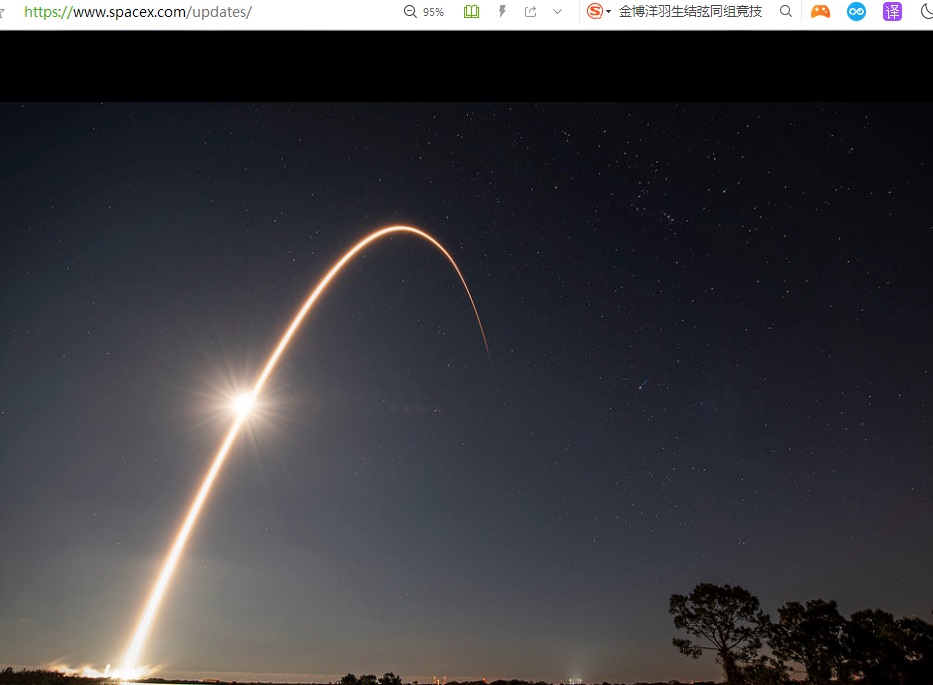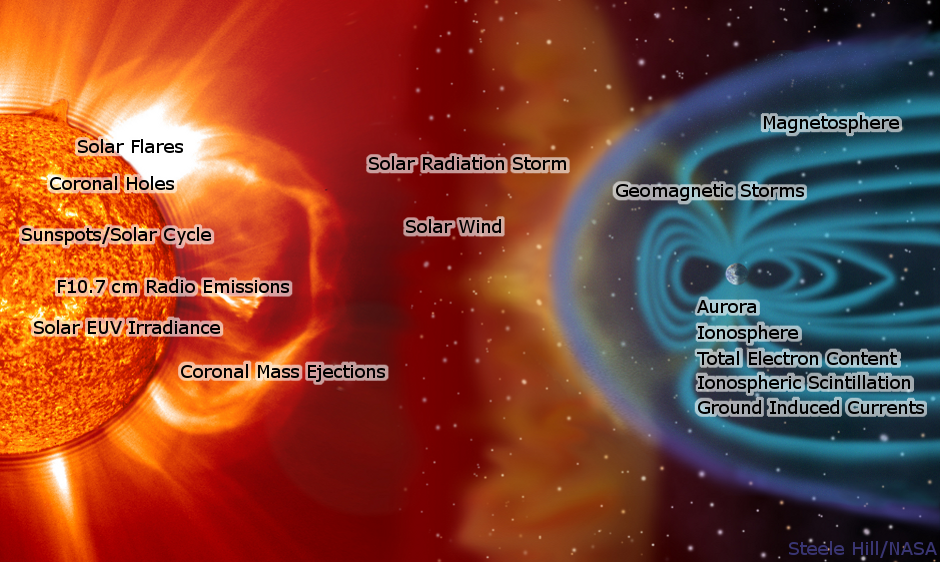
周三(2022年2月3日)發射49顆星鏈衛星,周四(2月4日)40顆衛星受太陽磁暴影響進入大氣層燒蝕損毀,預計這次發射和衛星損失高達五千萬美元。
目前SpaceX已經發射1900顆星鏈衛星,現有14.5萬個用戶。
當地時間2月9日,馬斯克的太空探索技術公司(SpaceX)發布官方消息稱,于今年2月3日發射的49顆星鏈衛星中的40顆已經被一場地磁風暴給毀掉了,預估這些衛星將在不久之后重返大氣層銷毀,剩下的9顆又難以成組在軌組網承擔信號傳播任務。

馬斯克的星鏈太空互聯網衛星計劃預備向地球的近地軌道發射4萬顆互聯網衛星,以建立覆蓋整個地球的 Internet互聯網絡,至今已經發射了2000顆左右,今年的2月3日,SpaceX公司用獵鷹9號火箭發射了49顆Starlink組網衛星,這些衛星原計劃在發射后不久就被送到了距地面210公里的低近地軌道上,在這里進行調試后,衛星將啟動電推進系統上升到距地面520公里的運行軌道上,完成最終的部署,結果調試工作還沒完成就遭遇到了一場大級別的地磁風暴,被摧毀了40顆衛星,這次發射算是白費了。

在較低軌道部署的星鏈衛星第二天受到磁暴的嚴重影響,導致大氣變暖,大氣密度增加,星載GPS顯示磁暴導致大氣阻力較發射前增加了50%,星鏈團隊命令衛星進入安全模式,衛星在該模式下可以側著飛行(fly edge-on),就像一張紙一樣,這樣可以最大減少阻力,有效“躲避風暴”。

初步分析顯示,因大氣阻力的增加阻止星鏈衛星離開安全模式,不能提升軌道機動,多達40顆衛星重入大氣層,不會與其他衛星發生碰撞,且不會有碎片掉落地面。
當地時間2月7日凌晨2時40分左右,加勒比天文學會(SAC)的流星監控相機記錄到了空間碎片再入大氣層,其中的幾個碎片可能是這次受磁暴影響的星鏈衛星有關。值得一提的是,空間碎片再入大氣層的速度,比流星要慢很多,也很壯觀。
地磁風暴是什么?太陽內部時刻都在進行著核聚變反應,使得其內部溫度高達1,500萬℃,這些能量也會向外輻射,突破太陽的表面噴發到太空中,在我們看來就是太陽表面出現了耀斑,這時候。太陽就會從耀斑處噴發出大量的太陽風,這些太陽風大部分都是由氫氦等離子體形成的,其噴射速度可達每秒500~1200公里,是空氣中音速的數千倍。
當這些帶電太陽風來到地球附近的時候,在大約7萬公里外就會受到地球磁場磁力線的干擾,從而使得等離子太陽風沿著磁力線的方向向地球的兩極靠攏,越靠近兩極太陽風粒子密度越大,于是就出現了極光現象,所以從本質上來說,極光本身就是一種磁暴。
由于地球周圍的衛星運行軌道的高度大都在地表以上3萬公里以內,而地球磁場的有效保護范圍可達地表以上7萬公里,所以太陽風不會經常性地損毀太空中的衛星,但是如果太陽風足夠強,地球外太空的磁力線無法完全阻擋太陽風的侵襲,那么這些帶電粒子就會形成大范圍的磁暴,從而影響到地球周圍運行的衛星了。

磁暴現象(Magnetic Storm)
磁暴現象是指當太陽表面活動旺盛,特別是在太陽黑子極大期時,太陽表面的閃焰爆發次數也會增加,閃焰爆發時會輻射出X射線、紫外線、可見光及高能量的質子和電子束。其中的帶電粒子(質子、電子)形成的電流沖擊地球磁場,引發地磁擾動現象稱為磁暴。
所謂強烈是相對各種地磁擾動而言。其實地面地磁場變化量較其平靜值是很微小的。在中低緯度地區,地面地磁場變化量很少有超過幾百納特的(地面地磁場的寧靜值在全球絕大多數地區都超過 3萬納特)。一般的磁暴都需要在地磁臺用專門儀器做系統觀測才能發現。
磁暴是常見現象。不發生磁暴的月份是很少的,當太陽活動增強時,可能一個月發生數次。有時一次磁暴發生27天(一個太陽自轉周期)后,又有磁暴發生。這類磁暴稱為重現性磁暴。重現次數一般為一、二次。
“磁暴”現象整個地球是一個大磁場,地球的周圍充滿了磁力線。當耀斑出現時,其附近向外發射高能粒子,帶電的粒子運動時產生磁場,當它到達地球時,便擾亂原來的磁場,引起地磁的變動,一般產生在耀斑爆發后20—40小時。發生磁暴時,磁場強度變化很大,對人類活動特別是與地磁有關的工作會有很大影響。
影響地球大氣太陽的遠紫外線和太陽風會影響大氣的密度,大氣密度的變化周期為11年,顯然與太陽活動有關。太陽活動還可能影響到大氣溫度和臭氧層,進而影響到農作物的產量和自然生態系統的平衡。
由于太陽活動對人類有影響,特別是對航天、無線電通訊、氣象等方面影響顯著,因此,研究太陽活動,特別是太陽耀斑發生的規律,并設法進行預報,具有重要的應用價值。
在20世紀60年代,科學家們用空間探測器證實了太陽風的存在。當太陽上面有大的爆發現象(太陽爆發、色球爆發等),特別是強烈的耀斑出現時,太陽風帶電微粒急增。由于地磁場的作用,太陽風里相當一部分的帶電微粒,沿著磁力線回旋在南、北磁場附近的地球高空中。
這樣,處在高層大氣中的各種氣體原子和分子會受到帶電粒子的撞擊、電離和激發,從而使之產生出一種類似于充氣管所出現的輝光,這便是極光現象;與此同時,在地球的磁場里往往會發生明顯的磁暴現象,電訊中斷了,指南針的磁針發了瘋似的亂轉。
A geomagnetic storm is a major disturbance of Earth's magnetosphere that occurs when there is a very efficient exchange of energy from the solar wind into the space environment surrounding Earth. These storms result from variations in the solar wind that produces major changes in the currents, plasmas, and fields in Earth’s magnetosphere. The solar wind conditions that are effective for creating geomagnetic storms are sustained (for several to many hours) periods of high-speed solar wind, and most importantly, a southward directed solar wind magnetic field (opposite the direction of Earth’s field) at the dayside of the magnetosphere. This condition is effective for transferring energy from the solar wind into Earth’s magnetosphere.
The largest storms that result from these conditions are associated with solar coronal mass ejections (CMEs) where a billion tons or so of plasma from the sun, with its embedded magnetic field, arrives at Earth. CMEs typically take several days to arrive at Earth, but have been observed, for some of the most intense storms, to arrive in as short as 18 hours. Another solar wind disturbance that creates conditions favorable to geomagnetic storms is a high-speed solar wind stream (HSS). HSSs plow into the slower solar wind in front and create co-rotating interaction regions, or CIRs. These regions are often related to geomagnetic storms that while less intense than CME storms, often can deposit more energy in Earth’s magnetosphere over a longer interval.
Storms also result in intense currents in the magnetosphere, changes in the radiation belts, and changes in the ionosphere, including heating the ionosphere and upper atmosphere region called the thermosphere. In space, a ring of westward current around Earth produces magnetic disturbances on the ground. A measure of this current, the disturbance storm time (Dst) index, has been used historically to characterize the size of a geomagnetic storm. In addition, there are currents produced in the magnetosphere that follow the magnetic field, called field-aligned currents, and these connect to intense currents in the auroral ionosphere. These auroral currents, called the auroral electrojets, also produce large magnetic disturbances. Together, all of these currents, and the magnetic deviations they produce on the ground, are used to generate a planetary geomagnetic disturbance index called Kp. This index is the basis for one of the three NOAA Space Weather Scales, the Geomagnetic Storm, or G-Scale, that is used to describe space weather that can disrupt systems on Earth.
During storms, the currents in the ionosphere, as well as the energetic particles that precipitate into the ionosphere add energy in the form of heat that can increase the density and distribution of density in the upper atmosphere, causing extra drag on satellites in low-earth orbit. The local heating also creates strong horizontal variations in the in the ionospheric density that can modify the path of radio signals and create errors in the positioning information provided by GPS. While the storms create beautiful aurora, they also can disrupt navigation systems such as the Global Navigation Satellite System (GNSS) and create harmful geomagnetic induced currents (GICs) in the power grid and pipelines.
參考資料及信息來源:SpaceX、科普大世界、BBC、CNBC。
